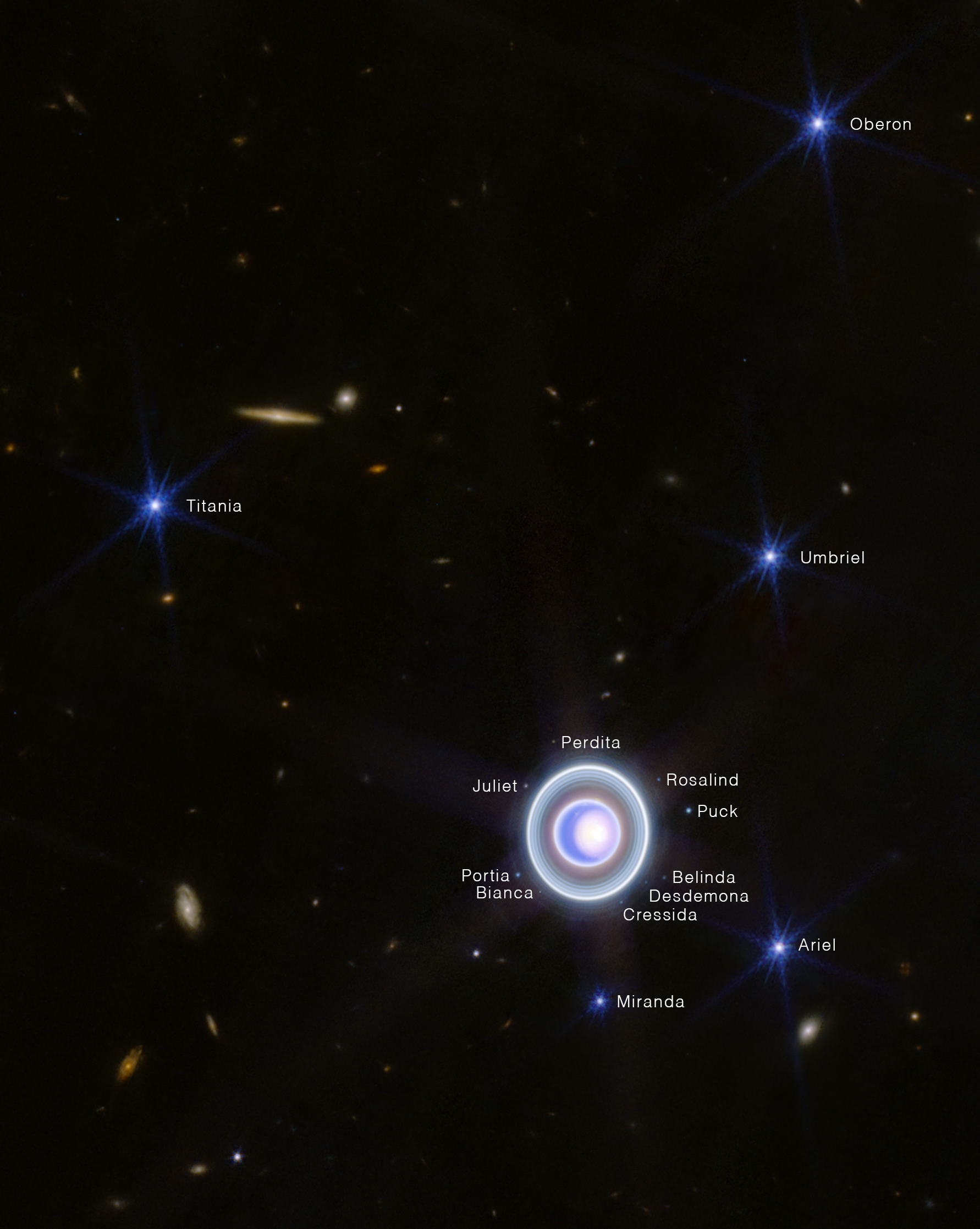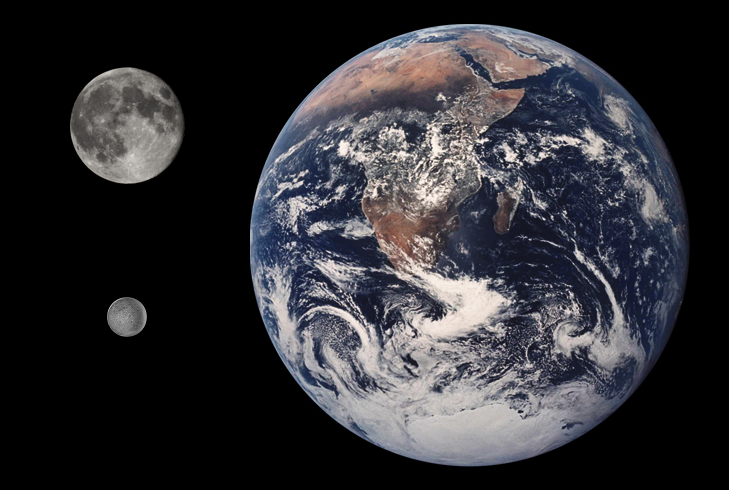|
Umbriel
Umbriel () is the third-largest moon of Uranus. It was discovered on October 24, 1851, by William Lassell at the same time as neighboring moon Ariel. It was named after a character in Alexander Pope's 1712 poem '' The Rape of the Lock''. Umbriel consists mainly of ice with a substantial fraction of rock, and may be differentiated into a rocky core and an icy mantle. The surface is the darkest among Uranian moons, and appears to have been shaped primarily by impacts, but the presence of canyons suggests early internal processes, and the moon may have undergone an early endogenically driven resurfacing event that obliterated its older surface. Covered by numerous impact craters reaching in diameter, Umbriel is the second-most heavily cratered satellite of Uranus after Oberon. The most prominent surface feature is a ring of bright material on the floor of Wunda crater. This moon, like all regular moons of Uranus, probably formed from an accretion disk that surrounded the ... [...More Info...] [...Related Items...] OR: [Wikipedia] [Google] [Baidu] |
Moon Of Uranus
Uranus, the seventh planet of the Solar System, has 28 confirmed moons. The 27 with names are named after characters that appear in, or are mentioned in, William Shakespeare's plays and Alexander Pope's poem '' The Rape of the Lock''. Uranus's moons are divided into three groups: thirteen inner moons, five major moons, and ten irregular moons. The inner and major moons all have prograde orbits and are cumulatively classified as regular moons. In contrast, the orbits of the irregular moons are distant, highly inclined, and mostly retrograde. The inner moons are small dark bodies that share common properties and origins with Uranus's rings. The five major moons are ellipsoidal, indicating that they reached hydrostatic equilibrium at some point in their past (and may still be in equilibrium), and four of them show signs of internally driven processes such as canyon formation and volcanism on their surfaces. The largest of these five, Titania, is 1,578 km in diameter and ... [...More Info...] [...Related Items...] OR: [Wikipedia] [Google] [Baidu] |
Miranda (moon)
Miranda, also designated Uranus V, is the smallest and innermost of Uranus's five round natural satellite, satellites. It was discovered by Gerard Kuiper on 16 February 1948 at McDonald Observatory in Texas, and named after Miranda (The Tempest), Miranda from William Shakespeare's play ''The Tempest''. Like the other large moons of Uranus, Miranda orbits close to its planet's equatorial plane. Because Uranus orbits the Sun on its side, Miranda's orbit is nearly perpendicular to the ecliptic and shares Uranus's extreme seasonal cycle. At just in diameter, Miranda is one of the smallest closely observed objects in the Solar System that might be in hydrostatic equilibrium (spherical under its own gravity), and its total surface area is roughly equal to that of the U.S. state of Texas. The only close-up images of Miranda are from the ''Voyager 2'' probe, which made observations of Miranda during its Uranus flyby in January 1986. During the flyby, Miranda's southern hemisphere po ... [...More Info...] [...Related Items...] OR: [Wikipedia] [Google] [Baidu] |
Wunda (crater)
Wunda is a large impact crater, crater on the surface of Uranus' moon Umbriel. It is 131 km in diameter and is located near the equator of Umbriel. The crater is named after ''Wunda'', a dark spirit of Australian aboriginal mythology. Wunda has a prominent albedo#Astronomical albedo, albedo feature on its floor, which takes the shape of a ring of bright material at least 10 km in radial width. The reason for its brightness, which stands out from the very dark composition of the moon as a whole, is unknown. It may be either a fresh impact deposit or a deposit of carbon dioxide ice, which formed when the Radiolysis, radiolytically formed carbon dioxide migrated from all over the surface of Umbriel and got trapped inside relatively cold Wunda. References Citations Sources * * * Impact craters on Uranus' moons Umbriel {{crater-stub ... [...More Info...] [...Related Items...] OR: [Wikipedia] [Google] [Baidu] |
Titania (moon)
Titania (), also designated Uranus III, is the largest moon of Uranus. At a diameter of it is the List of natural satellites by diameter, eighth largest moon in the Solar System, with a surface area comparable to that of Australia. Discovered by William Herschel in 1787, it is named after the Titania (A Midsummer Night's Dream), queen of the fairies in Shakespeare's ''A Midsummer Night's Dream''. Its orbit lies inside Uranus's magnetosphere. Titania consists of approximately equal amounts of ice and rock (geology), rock, and is probably differentiated into a rocky core (geology), core and an icy mantle (geology), mantle. A layer of liquid water may be present at the core–mantle boundary. Its surface, which is relatively dark and slightly red in color, appears to have been shaped by both impacts and endogenic processes. It is covered with numerous impact craters reaching up to in diameter, but is less heavily cratered than Oberon (moon), Oberon, outermost of the five large mo ... [...More Info...] [...Related Items...] OR: [Wikipedia] [Google] [Baidu] |
Ariel (moon)
Ariel is the fourth-largest moons of Uranus, moon of Uranus. Ariel orbits and rotates in the equatorial plane of Uranus, which is almost perpendicular to the orbit of Uranus, so the moon has an extreme seasonal cycle. It was discovered on 24 October 1851 by William Lassell and named for a character in two different pieces of literature. As of 2019, much of the detailed knowledge of Ariel derives from a single flyby (spaceflight), flyby of Uranus performed by the space probe ''Voyager 2'' in 1986, which managed to image around 35% of the moon's surface. There are no active plans at present to return to study the moon in more detail, although various concepts such as a Uranus Orbiter and Probe have been proposed. After Miranda (moon), Miranda, Ariel is the second-closest of Uranus's five Major moon, major rounded satellites. Among the smallest of the Solar System's Major moon, 20 known spherical moons (it ranks 14th among them in diameter), it is believed to be composed of roughl ... [...More Info...] [...Related Items...] OR: [Wikipedia] [Google] [Baidu] |
Uranus
Uranus is the seventh planet from the Sun. It is a gaseous cyan-coloured ice giant. Most of the planet is made of water, ammonia, and methane in a Supercritical fluid, supercritical phase of matter, which astronomy calls "ice" or Volatile (astrogeology), volatiles. Atmosphere of Uranus, The planet's atmosphere has a complex layered cloud structure and has the lowest minimum temperature () of all the Solar System's planets. It has a marked axial tilt of 82.23° with a Retrograde and prograde motion, retrograde rotation period of 17 hours and 14 minutes. This means that in an 84-Earth-year orbital period around the Sun, its poles get around 42 years of continuous sunlight, followed by 42 years of continuous darkness. Uranus has the third-largest diameter and fourth-largest mass among the Solar System's planets. Based on current models, inside its volatile Mantle (geology), mantle layer is a rocky core, and surrounding it is a thick hydrogen and helium atmosphere. Trace amount ... [...More Info...] [...Related Items...] OR: [Wikipedia] [Google] [Baidu] |
Oberon (moon)
Oberon , also designated , is the outermost and second-largest major moon of the planet Uranus. It is the second-most massive of the Uranian moons, and the tenth-largest moon in the Solar System. Discovered by William Herschel in 1787, Oberon is named after the mythical king of the fairies who appears as a character in Shakespeare's ''A Midsummer Night's Dream''. Its orbit lies partially outside Uranus's magnetosphere. Oberon likely formed from the accretion disk that surrounded Uranus just after the planet's formation. The moon consists of approximately equal amounts of ice and rock, and is probably differentiated into a rocky core and an icy mantle. A layer of liquid water may be present at the boundary between the mantle and the core. The surface of Oberon, which is dark and slightly red in color, appears to have been primarily shaped by asteroid and comet impacts. It is covered by numerous impact craters reaching 210 km in diameter. Oberon possesses a system of ' ... [...More Info...] [...Related Items...] OR: [Wikipedia] [Google] [Baidu] |
The Rape Of The Lock
''The Rape of the Lock'' is a mock-heroic narrative poem written by Alexander Pope. One of the most commonly cited examples of high burlesque, it was first published anonymously in Lintot's ''Miscellaneous Poems and Translations'' (May 1712) in two cantos (334 lines); a revised edition "Written by Mr. Pope" followed in March 1714 as a five-canto version (794 lines) accompanied by six engravings. Pope boasted that this sold more than three thousand copies in its first four days. The final form of the poem appeared in 1717 with the addition of Clarissa's speech on good humour. The poem was much translated and contributed to the growing popularity of mock-heroic in Europe. Description The poem of ''The Rape of the Lock'' satirises a minor incident of life, by comparing it to the epic world of the gods, and is based on an event recounted to Alexander Pope by his friend John Caryll. Arabella Fermor and her suitor, Lord Petre, were each a member of aristocratic recusant Ca ... [...More Info...] [...Related Items...] OR: [Wikipedia] [Google] [Baidu] |
Synchronous Rotation
Tidal locking between a pair of co-orbiting astronomical bodies occurs when one of the objects reaches a state where there is no longer any net change in its rotation rate over the course of a complete orbit. In the case where a tidally locked body possesses synchronous rotation, the object takes just as long to rotate around its own axis as it does to revolve around its partner. For example, the same side of the Moon always faces Earth, although there is some variability because the Moon's orbit is not perfectly circular. Usually, only the satellite is tidally locked to the larger body. However, if both the difference in mass between the two bodies and the distance between them are relatively small, each may be tidally locked to the other; this is the case for Pluto and Charon, and for Eris and Dysnomia. Alternative names for the tidal locking process are gravitational locking, captured rotation, and spin–orbit locking. The effect arises between two bodies when their g ... [...More Info...] [...Related Items...] OR: [Wikipedia] [Google] [Baidu] |
William Lassell
William Lassell (18 June 1799 – 5 October 1880) was an English merchant and astronomer.AN 98(1881) 108 He is remembered for his improvements to the and his ensuing discoveries of four planetary satellites. Life William Lassell was born in , Lancashire, on 18 June 1799. He received his early education in Bolton and later attended |








